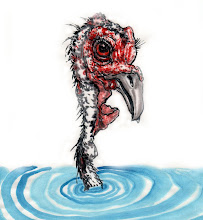


 Last week, I managed to get to Disjecta and the Templeton Building, two venues for the Portland Biennial. The whole concept of biennial is fraught with danger and excitement. Here we have someone, in this case curator Chris Moss, push some artists and artwork forward with the judgement that they are among the best of the region or at the very least a good representation of what is going on in the Portland art world. Having it at multiple venues with a large group of artists diffuses the American Idol aspects of the event. I have to admit part of the fun of viewing a biennial is being able to question some one's attempt to sort through what is an endless and nebulous art world and create some winners and losers. How much influence this Biennial will have on artist's career (meaning their ability to make money) and the direction of the Portland's art scene is hard to know. I know quite a few artists that were in Biennials when it was held at the museum, most still have their day jobs. Some aren't making art anymore.
Last week, I managed to get to Disjecta and the Templeton Building, two venues for the Portland Biennial. The whole concept of biennial is fraught with danger and excitement. Here we have someone, in this case curator Chris Moss, push some artists and artwork forward with the judgement that they are among the best of the region or at the very least a good representation of what is going on in the Portland art world. Having it at multiple venues with a large group of artists diffuses the American Idol aspects of the event. I have to admit part of the fun of viewing a biennial is being able to question some one's attempt to sort through what is an endless and nebulous art world and create some winners and losers. How much influence this Biennial will have on artist's career (meaning their ability to make money) and the direction of the Portland's art scene is hard to know. I know quite a few artists that were in Biennials when it was held at the museum, most still have their day jobs. Some aren't making art anymore.The Templeton Building and Disjecta are both large, cavernous spaces. Much of the artwork in both places is large to match. Multiple artists created installations that in some way react to the space. There is no painterly painting or hand formed sculpture. I suppose that kind of art might feel a bit quaint in these two venues. Concepts rule. Each installation felt like it could be dazzlingly defended in front of a MFA thesis jury. For me, the large cavernous buildings were hard to get past when looking at the work. No matter how bright the flood lights or colorful the artwork high up above there was that impenetrable darkness of old Northwest wood hanging like a rain cloud.
The photography in the show was all printed in very large format...life size or bigger. I always enjoy looking at photography. The work by Corey Arnold and Holly Andres was interesting. Even though they very different subject matter, somehow they seemed connected by a certain coolness or melancholy. I wondered what either of the work would be like if it was printed in a smaller....say book size format. Do they need to be large to have an impact? I suppose everything has more impact or at least is harder to ignore if it is large. Imagine a billboard that covers half the sky. That would be hard to ignore.
My favorite work of either venue is West Coast Turnaround, created by Crystal Schenk and Shelby Davis. It is a white life-size model of a semi-truck crammed between two walls in the Disjecta building. Out of the many attempts in this biennial to do something with the architectural space, West Coast Turnaround did so with a sense of fun and profoundity. It brought out personal issues I have with menacing large trucks on the road. I could approach the work cautiously and admire it's size and shape with only a slight fear that I might get run over.





